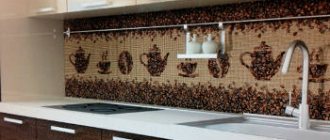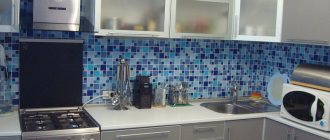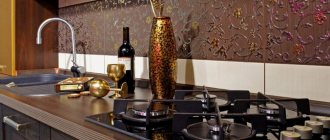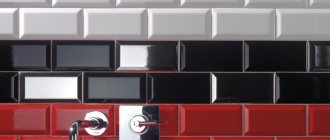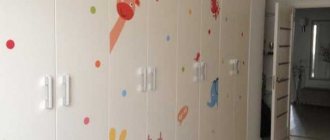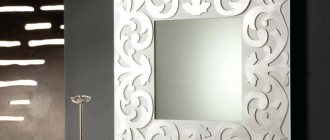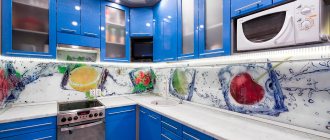The kitchen apron is the part of the wall between the countertop and the upper cabinets. The main purpose of the apron is to protect the wall from moisture, dirt and drops of grease. That is why the main requirement for an apron is its strength, ease of maintenance and resistance to moisture and temperature changes.
A kitchen apron is not only about decorating the space between cabinets, but also creating a coating that is not susceptible to dirt
Not all materials meet the criteria, so the choice of aprons is quite limited. One of the most popular and inexpensive options is an MDF apron.
MDF aprons have excellent strength properties
What is MDF?
It is very common to decipher MDF as a finely dispersed texture. Even professional furniture makers cannot explain what is hidden under this term. And this is not surprising - this interpretation is actually wrong. The abbreviation MDF is a tracing paper from the English Medium Density Fideboar, which means medium density fiberboard. Really, this makes it clearer?
Formaldehyde is not used in the manufacture of MDF; these panels are considered safe
MDF is crushed shavings pressed in a special way using high temperature and pressure, bonded with lingin - an environmentally friendly and healthy binder. The material is highly durable and quite resistant to moisture and temperature changes. It does not emit toxic substances when heated, so it is recommended for use as a kitchen apron.
Design
If you decide not to hang kitchen hanging cabinets on a wall, then you can completely decorate it with MDF panels with photo printing, this will allow the kitchen to become a warmer and quieter room.
Read on topic: How to unclog a kitchen sink
If your kitchen is made in light colors, then you can opt for a kitchen apron with a pattern of flowers, butterflies, ocean, and nature. A bright apron made of MDF with photo printing will dilute the room, adding color to it.
An image of a city at night will add zest to a kitchen designed in a modern or minimalist style.
If you have a small kitchen, then opt for a light-colored apron made of MDF panels with photo printing.
Kitchen furniture in bright colors is well balanced by MDF panels with a natural texture, made to look like wood, bamboo or stone. But such an apron should be in harmony with the floor covering.
An apron made using MDF panels with 3D printed images will become an extraordinary decorative element, transforming the kitchen space and giving it a completely new, stylish and extraordinary appearance.
Photo printing
The next important factor that is worth checking with the manufacturer is the method of applying the image to the panel. There are only three of them.
- The first is that the image is applied using special ink.
- In the second method, the image is applied to MDF by gluing a film with the desired image.
- The third and most expensive is applying photo printing to an acrylic surface, which is glued to MDF. Such panels have the highest quality color retention, are heat-resistant and are not afraid of moisture.
Selecting a drawing
As we noted earlier, in principle, it is possible to depict a wide variety of designs on an MDF panel. You should ask the manufacturer about the range of possibilities.
Practice shows that you shouldn’t get too carried away when choosing an image for photo printing. It must be remembered that an apron is, first and foremost, a work surface. Accordingly, it is advisable to find a middle ground between beauty and practicality.
Let's look at these photos to see what images and drawings other people choose for photo printing on an MDF apron.
Vegetables and fruits have long become the main “characters” in many kitchens.
Some people really like night cityscapes, especially American cities.
Flower fields and arrangements are also very popular. This is due to the incredible color and richness of such images.
Advantages and disadvantages
Like any other material, MDF has its pros and cons. We have collected them in one table to make it easier for you to decide whether this option is suitable for your kitchen.
Advantages:
- The main advantage of an MDF apron is its low price. It is much more affordable than stone, enamel or solid wood backsplashes.
- Resistance to mechanical damage. A high-quality MDF apron can withstand accidental impacts without cracks or scratches.
- High resistance to moisture. This allows the material to be used even above the sink and stove, where condensation often forms.
- Installation of MDF apron panels is very simple , you can easily do it yourself.
- Easy care . Unlike glass or tile aprons, MDF does not require special detergents and can be washed in a matter of minutes
- Huge range of design possibilities . MDF is decorated to resemble wood or stone, painted with designs, and painted in various colors. It’s easy to choose the right apron for any interior style.
- MDF has excellent thermal insulation properties . If you use it not only for the apron, but also for finishing the remaining walls, the kitchen will be noticeably warmer.
- If desired, you can hide wiring and communications behind the panels . To do this, it is necessary to attach them not directly to the wall, but with a small gap to the sheathing.
- MDF boards are resistant to mold and mildew.
Flaws:
- An MDF apron cannot be installed directly above a gas stove . It may become deformed due to overheating.
- It is imperative to cover the ends of the panel with a plastic or aluminum profile to avoid moisture and dirt getting on the cut. Otherwise, the panel may swell from the inside and become deformed.
- The panels can easily withstand impacts, but they must be protected from sharp objects. Knives and utensil edges can leave unsightly scratches.
- Even the highest quality imitation will not look completely natural.
However, in general, the shortcomings are insignificant and, with careful handling of the apron, are almost invisible. Therefore, we confidently recommend MFD for kitchen backsplashes.
One of the advantages of such an apron is its availability; you can order it from literally any organization that produces furniture
Which apron for the kitchen should you choose and not regret it? Expert advice.
Kitchen apron: tips for choosing:
The kitchen apron plays an important role in the interior design of the kitchen space. A wall panel on the central working wall protects it from wear and tear, has an aesthetic function, can visually change the geometry of the room, shapes the interior style and creates a feeling of harmony.
The versatility of a kitchen apron is achieved only if the choice of finishing material is made correctly. In the opposite situation, a polar effect can be achieved. A finish that is not durable enough will last less than the consumer hopes. The design of a wall panel may be in dissonance with the overall ambiance of the room. If you choose the wrong apron, the external perception of space will be spoiled.
The situation is aggravated by the fact that the modern construction market offers a huge variety of variations for kitchen finishing. Let's try to understand the advantages and disadvantages of the main types of finishing materials and give practical recommendations on the optimal choice of kitchen apron.
Criterias of choice:
Evaluation of the qualities of a kitchen apron as a finishing material is determined by its functions. An important factor, and for most citizens a priority, is cost. Accordingly, the selection criteria for significance are:
- Kitchen apron price.
- Practicality.
- Life time.
- Aesthetics.
- Style.
- Personal taste.
- Dimensions and configuration of the apron.
For each consumer, the priority of criteria is deeply individual. For some, the determining factor is the price, while for others, originality and external effect are important. Let's consider the types and characteristics of kitchen aprons, ranging from the available varieties to the most expensive finishing options.
Kitchen apron made of ABS plastic:
Wall decoration with plastic is the most affordable decor option. The popularity of the material is enhanced by the fact that so-called ABS plastic has appeared on the market, which is characterized by increased performance and aesthetic qualities.
Advantages of ABS plastic:
- Non-toxic, environmentally friendly, safe for others.
- Lightweight, plastic, cuts well, does not undergo deformation.
- Can be painted and perfectly conveys a multi-color pattern.
- Thanks to photo printing technologies, it can be produced in any style.
- It has aesthetic appeal and a variety of colors.
- When the surface is treated with varnish, it has an external resemblance to glass.
- Easily mounted using liquid nails or self-tapping screws, installation is inexpensive.
- If you have simple installation skills, you can install it yourself.
- Easy to clean (soap solution and non-greasy sponge)
- The most affordable price is due to new low-cost technologies.
Flaws:
- Compared to some other finishing materials, the service life is shorter.
- It has temperature restrictions (max. +80 degrees), so it cannot be installed in the kitchen stove area (for gas stoves) without protective glass.
- When exposed to ultraviolet radiation, paints fade over time, so it is advisable to protect the panel from exposure to sunlight.
- It is not recommended to use abrasive products when caring for the surface; for washing, use only ordinary soapy water and a soft cloth.
Advice:
ABS plastic is considered the most inexpensive finishing material today. Provided there are sufficiently significant positive operational and aesthetic characteristics, the wall panel becomes popular and accessible to a wide range of consumers. A huge variety of stylistic compositions allows you to create a non-trivial design in a single copy.
Do you want unique and inexpensive decor? Choose the photo you like and place an order at COZYHOUSE or look at the catalog, where kitchen aprons are presented in the form of city landscapes, flower arrangements, abstract drawings, space and sea fantasies, in the form of your favorite animals.
MDF panels for kitchen splashback
MDF material is an advanced wood fiber composition obtained from wood sawdust, formed into a strong panel using harmless fastening elements. Finishing a kitchen apron with MDF panels, as well as ABS plastic, is one of the available room decor options.
Advantages:
- Environmentally friendly material - no toxic resins or phenol are used in its production.
- It looks beautiful and presentable because it has a perfectly smooth, glossy surface - plain painted or with wood imitation.
- It lends itself well to processing and cutting, and has a soft but durable structure from the point of view of use.
- It is easy to choose according to the decor - the apron is selected mainly to match the color of the table top or furniture, in any shade compositions.
- Incomparably cheaper than wood, it has a long service life.
- It is easy to paint, so you can perfectly choose the right color if you buy a custom-made kitchen apron.
- Over time, the canvas does not crack, deform, or swell.
- Easy installation, so if you have basic practical skills, you can install the MDF apron yourself.
- Inexpensive installation and affordable finishing costs compared to other materials.
- Just like ABS panels, the MDF apron can be easily dismantled, which, given its low price, allows you to change the finishing decor without burdensome financial investments.
Flaws:
- Limited choice of design solutions - in comparison with a similar budget type of ABS plastic finishing, MDF panels are made in popular natural shades, similar to natural wood, and can also be painted in any other colors, but without patterns, in a uniform color.
- Instability to moisture, which is why the apron made of MDF panels must be kept dry and constantly wiped with a soft, dry cloth.
- It is not recommended to use abrasive detergents or hard brushes during maintenance, as the surface is susceptible to scratches.
Advice:
MDF panels look ideal in classic-style rooms. Suitable for those who prefer wood in the kitchen interior, but refuse wood for various reasons. COZYHOUSE sells aprons for the kitchen, including those made from MDF. If you want to equip your kitchen space inexpensively, but tastefully, this is the ideal option.
Ceramic tiles for finishing a kitchen apron
Facing tiles on the construction market are presented in a wide price range and in a variety of styles. This expands your choice and opens up ways for relative cost savings.
Advantages:
- Practicality, resistance to mechanical stress, abrasion, temperature changes, chemicals, moisture.
- Easy to care for, no restrictions in the choice of detergents.
- A wide variety of colors, designs, patterns, sizes.
- Easy to match to the countertop, furniture, and other decorative elements.
- Depending on the design, it is suitable for all interior styles.
- Long service life.
Flaws:
- Not a cheap price - even at the lowest cost, tiling cannot be considered a budget option.
- Installation is complex and requires preliminary preparation of the walls and the participation of a professional craftsman, otherwise the installation will not bring the desired effect.
- High installation cost - in most cases, an average of 50% of the cost of the tiles must be added to the installation cost budget.
- Unlike ABS panels and MDF structures, which can be made without seams, ceramic tile decor has seams, which are quite tedious to maintain.
Advice:
When choosing ceramic tiles, follow the basic recommendations, which are as follows: a matte surface is easier to clean than a glossy one; It is better to choose dark grout, even for light tiles; in a classic interior, plain tiles or with an unobtrusive pattern are appropriate; You can add an accent using decorative ceramic panels.
Mosaic in the interior
Mosaic is a type of facing finish, consisting of small components of a uniform or different type and size. The mosaic is laid in the form of a pattern or design. The constituent elements are small ceramic tiles, pebbles, glass, porcelain stoneware, marble, and metal.
Advantages:
- It looks impressive and noble, the ambience of the room looks expensive and presentable.
- Almost never goes out of fashion, always up-to-date design.
- The strong texture of the material is designed for long service life.
- Shows resistance to water, mechanical stress, abrasive and chemical agents.
Flaws:
- The high cost of the material and expensive installation, the price of which depends on the complexity of the design.
- Many seams that are susceptible to contamination therefore require frequent cleaning.
Advice:
Mosaic is appropriate in luxurious interiors of modern and classic style. The overall ambience of the kitchen and furniture should be in a harmonious relationship with each other. If you want to reduce the cost of the project, choose an apron made of ABS plastic with a mosaic pattern.
Glass apron for the kitchen
Glass is becoming a popular decor for kitchen backsplashes.
Advantages:
- Durable, fireproof, can be installed near a gas stove.
- Easy to clean, does not scratch, does not deform, does not crack under the influence of normal mechanical loads, durable.
- Original design - posters and other inexpensive and fragile decorations, for example, photo wallpaper, photo collage, can be used as decoration.
- Unlimited range of design fantasies.
Flaws:
- Tempered glass is expensive.
- The glass apron is made to individual sizes, to order, since the glass is cut in production conditions.
- Complex production and difficult installation, which requires professionalism.
Advice:
If you want to install a glass apron in your kitchen, use the photo printing technique. Any pattern, drawing or photograph is applied to the back of the glass. In combination with glass, this type of apron is called skinali.
The COZYHOUSE company is ready to offer an inexpensive and alternative option. Glossy panels made of ABS plastic for the kitchen, varnished and based on photo printing, are similar to a glass surface, but their cost is incomparably cheaper.
Artificial or natural stone
Stone in the interior looks stylish, luxurious, and fashionable. Depending on the types of finishes, the price varies. Granite, marble, and artificial agglomerate are used for decoration purposes.
Advantages:
- Durability, strength, abrasion resistance, easy care.
- Resistance to temperature changes, moisture, and abrasives.
- Stylish, effective design.
Flaws:
- High cost - prices for the material are more expensive than for ceramics, porcelain stoneware, glass.
- Complex and expensive installation, requiring high professionalism.
- Not suitable for every interior style.
Advice:
Do you like stone in the interior, but want to reduce the cost of decorating a kitchen backsplash? Choose the option of artistic imitation. Using relatively inexpensive ABS plastic or MDF panels and photo printing technology, they create wall panels in any style, including imitating natural stone. Find interesting ready-made compositions in the COZYHOUSE catalog or order an apron made from your own photo.
Color, style, size - how to choose?
We recommend choosing an apron for the kitchen after choosing furniture, flooring and textile design. The wall panel must be combined with one or more decorative elements. The size of the apron depends on the configuration of the room and the design of the furniture. The style should reflect personal tastes and match the general ambiance of the room.
How to care
MDF is a fairly easy-to-maintain material. Due to its properties, it does not attract dirt and dust. Therefore, when it gets dirty, it is enough to wipe it with a microfiber cloth or a soft sponge with soapy water. Do not use brushes, hard sponges, or abrasive detergents, especially if there is a pattern on the panel. You risk scratching the apron. If desired, you can apply polish to the surface. It will provide a beautiful shine, but it will be more difficult to clean - take this factor into account.
This type of apron can last quite a long time if you take care of it properly.
What is the appeal of a kitchen mosaic backsplash?
Before you decorate your kitchen with a mosaic apron, you should weigh the pros and cons of such a technique. Among the main advantages of a beautiful coating it is worth noting:
- variability of color interpretations;
- versatility of ready-made ornaments and prints;
- ease of cleaning;
- resistance to temperature fluctuations, which is very important for the kitchen;
- unlimited design possibilities.
A mosaic backsplash is quite easy to care for.
The key advantage of this solution is its ease of use and maintenance. The thing is that such a kitchen apron, made of special tiles, is coated with a special glaze. This material, by its nature, cannot accumulate dirt, since the pores of the mosaic tiles are securely closed.
That is why cleaning such an apron will not be difficult. Fresh stains can be removed in no time with a damp sponge dipped in soapy water. If food particles that have fallen onto the canvas have time to harden, or drops of fat have gotten onto the coating, you can clean them off with a steel wool and powders, including those containing abrasive particles.
Advice. This feature makes a mosaic apron stand out from other design solutions that can be damaged by cleaning products.
How to choose?
All the advantages of an MDF apron are relevant only if you have purchased high-quality panels.
Follow our selection tips so you don’t have to change your apron after a couple of months:
- MDF panels are made from 3 to 10 millimeters thick. The optimal thickness for an apron in the kitchen is 4 millimeters.
- Choose panels from trusted manufacturers who value their reputation. The brands KASTAMONU, Sonae Industria, P&M Kaindl, and Latat have proven themselves best in Russia. If you like a panel from another manufacturer, pay attention to the type of production. It is important that it be a full cycle - in this case the company is fully responsible for its product.
- Non-certified slabs may contain high levels of formaldehyde, a toxic substance hazardous to human health. Therefore, you should not try to save money - it is fraught with harm to your health.
- Pay attention to the place of purchase. It is important that the slabs are stored correctly, otherwise they may dry out or, conversely, gain moisture and quickly become deformed during use.
- As for design, choose MDF panels taking into account the overall interior of the kitchen. This can be either a wood-look apron or a covering with a pattern applied to it. It all depends on your preferences and the design of the room.
- Keep in mind that a light apron visually “raises” the cabinets, making the kitchen more spacious and taller, while a dark apron, on the contrary, lowers it.
A kitchen apron made of MDF can be an excellent addition to the interior
Mosaic kitchen apron: how to make it yourself
There is nothing extra complicated in laying tiles, but the order of work and some nuances of the technology must be followed.
First of all, you need to thoroughly prepare the surface of the kitchen wall where the apron will be. To do this, remove the old finish and then prime the surface. Why prime - so that the tiles are well fixed to the wall, and the apron does not begin to fall apart in pieces over time.
The ideal option is if you are laying tiles on the wall that are already fixed in a grid. Then it will lie flat and accurately hide some unevenness.
A mosaic kitchen apron will create a unique mood and make the interior truly luxurious
Related article: Design of a walk-through living room, living room combined with hallway
What you will need to create such a kitchen apron:
- The tile itself;
- Wool roller (to prime the surface);
- Building level;
- Glue;
- Scissors.
If you decide to use self-adhesive tiles under the apron, thoroughly degrease the wall surface.
To level the wall, use putty or plaster. To fix the tiles, purchase latex-based adhesive. It is durable and holds tiles well.
Installation nuances
We will not give you step-by-step installation instructions - you can easily find a detailed video on the Internet that will explain the process more clearly than the most detailed text.
But we’ll share some secrets that will make your work easier and ensure the beauty and durability of your apron:
- Sometimes MDF panels crack during installation. To avoid this, we recommend drilling several holes for self-tapping screws in advance. This will reduce the load on the canvas and avoid damage to the material.
- On the other hand, installing an MDF apron on dowels is not always acceptable from an aesthetic point of view. In this case, it is better to resort to the glue method. Choose a rubber-based adhesive composition: it provides reliable adhesion and has excellent waterproof characteristics. Choose proven brands such as Titan, Moment Montazh, LIQUID NAILS.
Advice! Before applying glue, be sure to thoroughly degrease both the surface of the MDF panel and the wall.
- If the wall is too uneven and you don’t want to waste time leveling it, attach the apron to a mounting grid or slats. This will smooth out any unevenness and ensure a beautiful appearance.
To prevent screws from spoiling the whole picture, you can use special screws with decorative caps to match the color of the panel
The main advantages of a mosaic apron
The use of small fragments for laying out the canvas ensures a neat appearance of the panel. Particularly attractive in this regard are compositions created from elements of contrasting shades. After cooking, food particles and splashes are not noticeable.
Among other advantages of this solution, it is worth noting practicality. The kitchen apron, made of special mosaic tiles, is heat-resistant and wear-resistant. The canvas, designed to decorate and protect the working wall, is not afraid of not only fluctuations in temperature levels.
Folding a mosaic apron in the kitchen is quite a complex and time-consuming job
In addition, the coating is resistant to aggressive influences:
- household chemicals;
- acids;
- dyes;
- moisture;
- condensate
Another undeniable advantage of decorating a mosaic apron in the kitchen is the ability to decorate the surface in a stylish, fashionable, non-trivial way. From this durable and reliable material you can create a wide variety of designer looks and extraordinary prints. That is why the coating can organically fit into almost any interior style.
A rich range of colors, the ability to recreate a relief coating or any level of complexity of artistic composition allow the material to harmoniously fit into classic interiors, Art Nouveau, Provence, country, retro, vintage, hi-tech, pop art, art deco and other trends.
Advice. In order for the canvas to be read effectively, it is recommended to decorate it only in spacious, free kitchens. Otherwise, the pattern of square tiles may turn out sketchy.
Design solutions
As we have already written, one of the advantages of MDF aprons is a large number of different design techniques that allow you to choose the right panel for almost any kitchen interior
The color scheme and design of the kitchen apron will depend on the amount of space and the preferences of the owner
Classic plain MDF aprons are available in a wide range of colors. It can be a classic white or black apron, or it can be any bright color - red, turquoise, indigo. It all depends on your desires - most companies supplying MDF panels can paint them in more than 200 shades.
A kitchen apron made of MDF can become the housewife's calling card
A popular technique is photo printing. This allows you to create a wide variety of designs. Very often they use aprons with wood or stone prints. Imitating natural material is much cheaper than natural panels. This technique is perfect for most classic styles.
You can choose the decor of the apron to match the tabletop or to match the facades
However, please note that the impression may vary depending on the quality of the print. The price can reach one and a half thousand rubles per square meter of print. We recommend not to save money - a blurry picture is unlikely to create the desired texture and will significantly reduce the cost of the impression of your kitchen.
This way you can apply other types of designs. Abstract patterns, vegetable and fruit still lifes, landscapes... Your imagination is not limited by anything. Except, perhaps, the chosen interior style.
Photo printing on an apron is a great way to transform your kitchen
Stereo printing is also popular. The method is more expensive than simple photo printing, but the result is an excellent quality 3D image. We recommend installing such aprons in large kitchens - in small ones the effect will be blurred.
In general, the choice of pattern depends on the dimensions of the room. For a small kitchen, it is better to choose light aprons with small, neat pictures, and for a spacious one, you can order a dark one, with a large-scale three-dimensional picture.
A light apron looks great, it will add tenderness to the kitchen
Often, MDF aprons are complemented with lighting around the perimeter. This technique makes the kitchen visually higher, and additional lighting makes kitchen work easier. If the backsplash is made of a thin panel, you can light it from the inside. Such lighting looks especially impressive with 3D drawings - they look really alive and decorate the kitchen.
Alternatives
If you are in doubt, take a look at other options for designing an apron in the kitchen.
The most common option is ceramic tiles. This solution has a number of undeniable advantages and virtually no disadvantages. We have already written about this in more detail in our review.
The second most popular can be safely called skinali - special glass surfaces on which the design of your choice is applied. Such panels look great and are great for modern interiors, but they are expensive and require special care. All the nuances of such aprons were discussed in the article on how to choose a glass apron.
If we talk about an alternative to MDF panels, based on the price-quality ratio, then the best replacement would be inexpensive tiles. You won’t have much difficulty finding good tiles in the budget segment. We recommend taking a closer look at Russian tile manufacturers; recently they have significantly expanded their range.
Against the backdrop of rising prices for everything imported, domestic tiles will allow you to save a lot without severely compromising quality. But you should immediately understand that if you want to lay out an apron at minimal cost, then you will have to sacrifice quality.
Made from MDF - what is it?
Most often, the word “skinali” is applied to aprons made of tempered glass with photo printing. According to reviews, moisture-resistant MDF panels can decorate the interior no worse than expensive glass. Kitchen skins made of this material will have one feature - the front side of the product is treated with a laminated plastic coating. Due to this decor, the panel becomes not just an MDF sheet, but a decorative skinnel, the surface of which can have the most daring colors, patterns and ornaments.
Most often, such skins are chosen when you need to complement the interior of the kitchen. For example, the room is decorated in country style. In this case, a regular MDF sheet will look unsightly.
But the glossy look of the wood-effect coating applied with will transform the interior. MDF skinali can be decorated with UV printing - you can choose an image of juicy fruit or an antique pattern.

